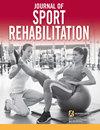Effective Stretching Positions of the Piriformis Muscle Evaluated Using Shear Wave Elastography.
IF 1.3
4区 医学
Q3 REHABILITATION
引用次数: 0
Abstract
CONTEXT Piriformis syndrome is often associated with muscle spasms and shortening of the piriformis muscle (PM). Physical therapy, including static stretching of the PM, is one of the treatments for this syndrome. However, the effective stretching position of the PM is unclear in vivo. This study aimed to determine the effective stretching positions of the PM using ultrasonic shear wave elastography. DESIGN Observational study. METHODS Twenty-one healthy young men (22.7 [2.4] y) participated in this study. The shear elastic modulus of the PM was measured at 12 stretching positions using shear wave elastography. Three of the 12 positions were tested with maximum internal rotation at 0°, 20°, or 40° hip adduction in 90° hip flexion. Nine of the 12 positions were tested with maximum external rotation at positions combined with 3 hip-flexion angles (70°, 90°, and 110°) and 3 hip-adduction angles (0°, 20°, and 40°). RESULTS The shear elastic modulus of the PM was significantly higher in the order of 40°, 20°, and 0° of adduction and higher in external rotation than in internal rotation. The shear elastic modulus of the PM was significantly greater in combined 110° hip flexion and 40° adduction with maximum external rotation than in all other positions. CONCLUSION This study revealed that the position in which the PM was most stretched was maximum external rotation with 110° hip flexion and 40° hip adduction.利用剪切波弹性成像技术评估提臀肌的有效拉伸位置
腓肠肌综合征通常与肌肉痉挛和腓肠肌(PM)缩短有关。物理疗法,包括对梨状肌的静态拉伸,是治疗这种综合征的方法之一。然而,PM 的有效拉伸位置在体内尚不明确。本研究旨在使用超声波剪切波弹性成像技术确定腓肠肌的有效拉伸位置。使用剪切波弹性成像技术测量了 PM 在 12 个拉伸位置的剪切弹性模量。在 12 个位置中,有 3 个位置是在髋关节屈曲 90°、髋关节内收 0°、20° 或 40°时进行最大内旋测试的。结果PM的剪切弹性模量在40°、20°和0°内收的顺序中明显较高,外旋时高于内旋时。在髋关节屈曲 110°、内收 40°、最大限度外旋的情况下,PM 的剪切弹性模量明显高于所有其他位置。
本文章由计算机程序翻译,如有差异,请以英文原文为准。
求助全文
约1分钟内获得全文
求助全文
来源期刊

Journal of Sport Rehabilitation
医学-康复医学
CiteScore
3.20
自引率
5.90%
发文量
143
审稿时长
>12 weeks
期刊介绍:
The Journal of Sport Rehabilitation (JSR) is your source for the latest peer-reviewed research in the field of sport rehabilitation. All members of the sports-medicine team will benefit from the wealth of important information in each issue. JSR is completely devoted to the rehabilitation of sport and exercise injuries, regardless of the age, gender, sport ability, level of fitness, or health status of the participant.
JSR publishes peer-reviewed original research, systematic reviews/meta-analyses, critically appraised topics (CATs), case studies/series, and technical reports that directly affect the management and rehabilitation of injuries incurred during sport-related activities, irrespective of the individual’s age, gender, sport ability, level of fitness, or health status. The journal is intended to provide an international, multidisciplinary forum to serve the needs of all members of the sports medicine team, including athletic trainers/therapists, sport physical therapists/physiotherapists, sports medicine physicians, and other health care and medical professionals.
 求助内容:
求助内容: 应助结果提醒方式:
应助结果提醒方式:


